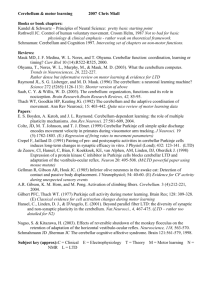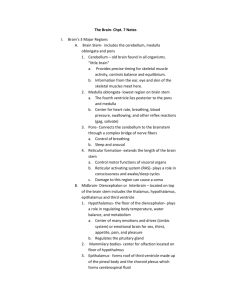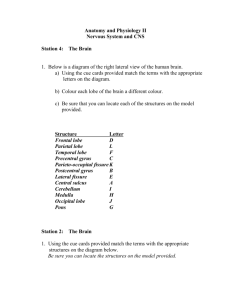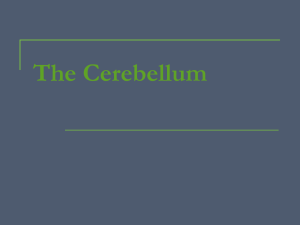1) an
advertisement
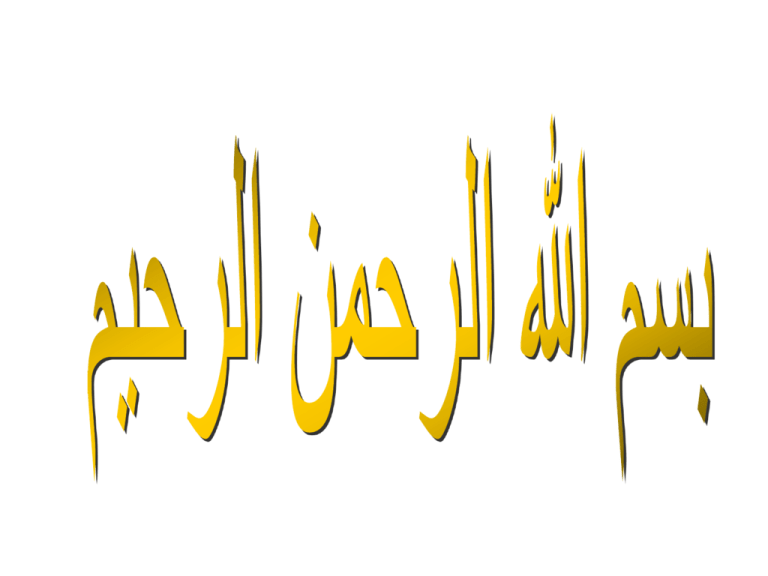
MAINTENANCE OF POSTURE AND BALANCE By Dr. Khalid Ibrahim Assistant Professor of Human Physiology • At the end of the session the students should be able to: • Describe the connections and functions of cerebellum. • Explain the levels of control in body posture. • Describe the body posture in spinal, decerebrate and decorticate conditions. Anatomical Divisions The cerebellum is attached to the brain stem by three pairs of tracts called the cerebellar peduncles which consist of numerous pathways connecting the cerebellum with several other centers in the nervous system. The body of the cerebellum is divided into two “hemispheres” connected at the midline by the “vermis”. Also, it is composed of an outer cortical gray matter (cerebellar cortex) surrounding a core of white matter which contains a group of nuclei (deep cerebellar nuclei). The cerebellar cortex is extensively folded by transverse fissures to increase its surface area. Two of these fissures ; the primary fissure and the posterolateral fissure, are deeper than others , dividing the cerebellum into 3 anatomical lobes : (i) The anterior lobe , (ii) The posterior lobe , and (iii) the flocculonodular lobe. Functional Divisions of the Cerebellum The cerebellum is functionally divided into longitudinal functional zones (a) The vermal zone, which occupies the vermis and is the most medial part of the cerebellar cortex. (b) The intermediate (or paravermal) zone of the cerebellar hemisphere, lying on each side of the vermis, occupying the medial regions of the cerebellar hemispheres. (c) The lateral zone of the cerebellar hemisphere, lying just lateral to the intermediate zone. In humans this region occupies the greater portion of the cerebellar hemisphere. On this basis, the different regions of the cerebellum are functionally organized into three major divisions: (i) The vestibulocerebellum. (ii) The spinocerebellum. (iii) The cerebrocerebellum. An alternative classification of the descending motor tracts is based on the sites of termination of these tracts in the spinal cord. On this basis , the descending motor pathways can be classified, with respect to their spinal sites of termination , into: Medial system Lateral system composed of tracts which terminate composed of tracts which terminate primarily on the ventromedial neurons (or primarily on the dorsolateral neurons their associated interneurons) (or their associated interneurons) innervate the trunk (axial) muscles and innervate the distal muscles of the the proximal (girdle) muscles of the limbs limbs. more concerned with postural control. more concerned with controlling fine voluntary extremities. movements of the There are five important sets of descending motor tracts, named according to the origin of their cell bodies and their final destination: 1) the corticobulbospinal tract, (= Pyramidal tract) 2) the rubrospinal tract, 3) the reticulospinal tracts, 4) the vestibulospinal tracts, and 5) the tectospinal tract. Extrapyramidal tracts I) The Vestibulocerebellum This functional region of the cerebellum is composed of the “flocculonodular lobe” has a close functional relationship with the vestibular system; so it has been named the “vestibulocerebellum”. vestibulocerebellum Neural Connections Efferents Reticular formation EYE Regulation of Equilibrium Afferents information about position & movements of the head. Fastigial nucleus Vestibular nuclei Folloculonodular lobe These connections enable it: 1) To control the activity of the motor pathways (the vestibulospinal and reticulospinal tracts) concerned with regulation of the tone and contractility of the antigravity muscles in response to vestibular sensory signals, and is therefore largely concerned with regulation of equilibrium. 2) To regulates movements of the eyeballs during head movements to maintain stable vision. II) The Spinocerebellum corresponds to the “vermis” plus the “ intermediate zone” of the cerebellar hemispheres on both sides of the vermis. Most of the sensory information reaching these regions of the cerebellum arrives from the spinal cord, “spinocerebellum”. Spinocerebellum thus they have been named the B) Peripheral Receptors Neural Connections Afferents A) Brain and Brainstem Centers Information about the “plan” of the movement ordered by the higher motor centers . Cerebral Cortex VSCT Thalamus DSCT Red Nucleus Reticular Formation Inferior olivary nucleus 1) The Dorsal Spinocerebellar Tract The “dorsal spinocerebellar tract” (DSCT) terminates ipsilaterally in the vermis and intermediate zone of the cerebellar hemisphere. These tracts provide the cerebellum with sensory signals from muscle spindles, Golgi tendon organs, joint receptors, and cutaneous touch and pressure receptors. These signals inform the cerebellum about the present state of muscle contraction, position of the body, and movements of its different parts. 2) The Ventral Spinocerebellar Tract The ventral spinocerebellar tract (VSCT) terminates ipsilaterally in the spinocerebellum. At its origin in the dorsal horn of the spinal gray matter, the ventral spinocerebellar tract receives a few afferent fibers from muscle and joint proprioceptors. In addition, it receives motor signals that reach it from:: (i) Collaterals of all the descending motor pathways (ii) The Local motor neurons in the spinal motor neuron pools. The ventral tract quickly returns to the spinocerbellum copies of the descending motor commands arriving at the spinal motor neuron pools. This feedback information is called the “efference copy” of the motor drive that finally reaches the spinal alpha and gamma motor neurons. Efferents A) From the Vermis Reticular Formation control the “axial” body musculature Regulation of Posture Vestibular nuclei Fastigial nucleus A) From the Intermediate zone Thalamus Red nucleus Globose nucleus control the “distal” body musculature Emboliform nucleus “Comparator” and “Error-Correction” Mechanism “Predictive” & “Damping” Mechanism III) The Cerebrocerebellum The cerebrocerebellum consists of the large “ lateral zones ” of the cerebellar hemispheres, just lateral to the intermediate zones. These regions of the cerebellum have no sensory input from peripheral tissues, but almost all of their afferent signals originate from the contralateral cerebral cortex therefore this functional region of the cerebellum is called the “cerebrocerebellum”. The cerebrocerebellum is the most recent from a phylogenetic point of view, so it is sometimes referred “neocerebellum”. to as the Neural Connections Afferents Efferents “Planning” the “Sequence” and “Timing” of Movements Cerebral Cortex Visual impulses VL nucleus of Thalamus Red nucleus Pontine nuclei Dentatel nucleus Afferents Almost all the afferent pathways to the cerebrocerebellum originate in the cerebral cortex . Most of these afferents pass by way of the “pontine nuclei” and the middle cerebellar peduncle to the lateral zone of the cerebellar hemisphere on the opposite side, via the “cortico - ponto cerebellar pathway”. The cerebral cortical projections into the cerebrocerebellum provide it with information from the motor areas concerning the motor command that is about to be discharged. Sensory information from the somatic sensory areas about the present postural state of the body , while that from the visual areas informs the cerebellum about the spatial position of the body in relation to the surrounding environment. Efferents The cortex of the cerebrocerebellum projects its efferent fibers to the “dentate” nucleus. The axons leaving the dentate nucleus pass through the superior peduncle to terminate mainly in the ventral lateral (VL) nucleus of the contralateral thalamus, which finally projects to the motor areas of the cerebral cortex. A smaller number of dentate axons terminate in the contralateral red nucleus. The “cerebello - dentato - cerebral” pathway mediates the role of the cerebrocerebellum in adjusting the plan of the motor command before being discharged from the cerebral cortical motor areas to the lower motor centers. Functions of the Cerebellum I) Regulation of Equilibrium As one starts to move or lose equilibrium, it is immediately sensed by the vestibular receptors. This is received and interpreted by the “vestibulocerebellum”, and immediate corrective signals are sent to (i)The vestibular nuclei, and reticular formation, to adjust the tone and contractility of the axial and proximal limb muscles. (ii) The superior colliculus and medial longitudinal fasciculus, to coordinate eye movements, so that a stable image of the visual field can be maintained on the retina. Clear vision is important for keeping equilibrium during head movements. II) Regulation of Posture The vermis is the principal region of the cerebellum concerned with postural adjustment. “vermis” receives sensory information from muscle and joint proprioceptors (particularly from the axial regions), concerning “position” of the body. Its output controls the vestibulospinal and reticulospinal pathways that principally regulate the tone and contraction of the axial and proximal limb muscles. III) Regulation (or Coordination) of Voluntary Movements: One of the most important features of normal motor activity is one’s ability to proceed smoothly and precisely from one movement to the next in proper succession. This is known as “coordination” of movements It is essentially one of the basic motor functions of the cerebellum . The cerebellar role in coordination of movements is carried on by a number of mechanisms , which include : 1)“Comparator” and “Error -Correction” Mechanism 2) “Predictive” and “Damping” Mechanism 3) “Planning” the “Sequence” and “Timing” of Movements 1)“Comparator” and “Error-Correction” Mechanism: AS the motor areas of the cerebral cortex send motor commands to muscles for performance of a voluntary movement, the spinocerebellum (particularly the intermediate zone of the cerebellar hemisphere) receives immediately: 1) an “efference copy” of the intended motor command through the cortico – ponto - cerebellar pathway. 2) Via the ventral spinocerebellar tract transmits back to the spinocerebellum another “efference copy” about the final motor signals that reach the anterior motor neurons of the spinal cord . 3) Via the dorsal spinocerebellar tract, proprioceptive signals from the moving parts of the body, especially from the distal parts of the limbs (as movement proceedes) , that tell the cerebellum what is actually taking place regarding movement and position of the limbs The intermediate zone of the spinocerebellum essentially acts as a “comparator” that compares the motor intentions of the higher centers with the actual performance of the involved muscles. When there is any “error” in performance or “deviation” from the original plan of the intended voluntary motor act, then the intermediate zone and the interposed nucleus send ‘corrective signals” back to the motor areas of the cerebral cortex and the red nucleus, which give origin to the descending motor tracts innervating mainly the lower motor neurons of the distal limb muscles. 2) “Predictive” and “Damping” Mechanism The cerebellum receives information regarding the velocity and direction of the intended movement, initially by means of the “efference copy” of the descending motor command, which is very soon followed by “sensory feed-back” signals from the muscles and joints of the moving parts of the body . The cerebellum would predict from these parameters how far that part of the body will move in a given time The cerebellum uses this information to determine the precise time to damp the movement, then it sends its decision to the motor cortex to stop the ongoing movement exactly at the intended position. 3) “Planning” the “Sequence” and “Timing” of Movements: The principal part of the cerebellum concerned with this coordination is the “cerebrocerebellum” (a) Planning the “Sequence” of Movements: the cerebrocerebellum uses the information provided from the cerebral cortex and the basal ganglia for planning the sequence of contraction of the different muscles involved in the voluntary motor act, to achieve the goal of the movement . Then, the “plan” of the movement sequence is transmitted from the cerebrocerebellum to the motor areas of the cerebral cortex, where it is used to adjust the final motor command before it is discharged to the lower motor centers. (b) Timing of Movements Another important role of the cerebrocerebellum is to provide perfect timing of voluntary movements. This is established by computing (calculating) the appropriate timing for the “onset” and “termination” of contraction of each of the muscles involved in the performance of the successive movements during voluntary motor acts. Accordingly, the cerebrocerebellum assures the smooth progression of the whole movement by providing accurate timing for proceeding from one movement to the next in complex motor acts . Neck Proprioceptors It gives CNS appropriate information about the orientation of the head with respect to the body. This information is transmitted from the proprioceptors of the neck and body directly to the vestibular and reticular nuclei in the brain stem and indirectly by way of the cerebellum. When the head is leaned in one direction by bending the neck, impulses from the neck proprioceptors keep the signals originating in the vestibular apparatus from giving the person a sense of dysequilibrium. They do this by transmitting signals that exactly oppose the signals transmitted from the vestibular apparatus. However, when the entire body leans in one direction, the impulses from the vestibular apparatus are not opposed by signals from the neck proprioceptors; therefore, in this case, the person does perceive a change in equilibrium status of the entire body. Other important receptors: 1) Pressure receptors in the foot. 2) Visual receptors. Some people with bilateral destruction of the vestibular apparatus have almost normal equilibrium as long as their eyes are open and all motions are performed slowly. Decerebrate vs decorticate lesions Decorticate means lesions of CNS above the level of midbrain (rubrospinal tract is intact) Decerebrate means lesions of CNS at a level between superior colliculi and inferior colliculi (rubrospinal tract is not intact) Spinal animal: Animals in which the connection between the spinal cord and brain is disconnected. Difference is due to: Rubrospinal is intact in the decorticate lesion causing flexion in the upper limb. Whereas in decerebrate lesion Rubrospinal is cut but reticulospinal and vestibulospinal are intact causing extension of both upper and lower limbs.


